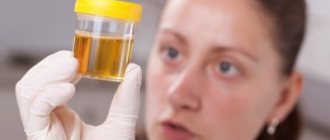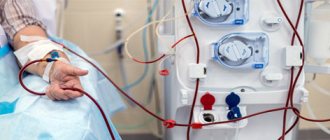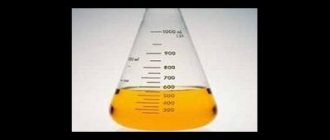Home > Treatment > Detoxification > Forced diuresis
Forced diuresis is a detoxification method that is based on the accelerated removal of toxins from the body by increasing the volume of urine produced. This effect is achieved by simultaneously introducing a large volume of fluid into the body and prescribing diuretics.
So, if minute diuresis is normally 0.5-1.0 ml per minute, then with forced diuresis this figure increases to 8-10 ml/min.
When conducting detoxification therapy, the chemical properties of the substance that needs to be removed from the body are taken into account. For good removal of toxins that exhibit alkaline properties (nicotine, procainamide, antihistamines, quinine, quinidine, imizine, phenamine, xanthine derivatives), the resulting urine must be made slightly acidic. And to remove substances that exhibit acidic properties (ethyl, methyl, isopropyl and other alcohols, barbiturates, ethylene glycol, salicylates, sulfonamides), the resulting urine must be slightly alkaline. With neutral urine, analgin, strychnine, phenacytine, bromides, fluorides, chloral hydrate, and meprotane are well excreted.
General characteristics of the method
The method of forced diuresis is based on artificially increasing the performance of the kidneys. The use of special diuretics allows you to remove more urine, which ensures faster removal of toxins from the body.
It has been established that in a healthy person the rate of urine excretion is 0.7-1.3 ml/minute. Forced diuresis allows you to increase this figure 10 times.
Due to this, the state of intoxication is quickly relieved (toxic substances are effectively removed from the body).
With the help of forced diuresis, you can free the body from the following compounds:
- salicylates;
- sulfonamides;
- barbiturates;
- alcohols – ethyl, methyl and others;
- ethylene glycol.
The procedure is also required in case of intolerance or overdose of antihistamines, bromides, quinine or analgesics.
This method is also effective for poisoning with heavy metals, nicotine, morphine and other drugs.
Forced diuresis is used to remove all substances processed by the kidneys.
The essence of the method: increasing the rate of formation of glomerular ultrafiltrate. This reduces the time it takes for the toxic substance to be reabsorbed in the kidney tubules and allows the toxin to be more efficiently eliminated in the urine.
In addition, depending on the characteristics of the poison that needs to be removed, the acidity of urine can be increased or decreased, which also significantly increases the effectiveness of the method.
This method is quite complicated. A large number of side effects and complications are possible. That is why treatment is allowed only in a hospital, under the constant supervision of doctors.
If all precautions are taken, there is no danger to the patient's life.
Therapeutic hyperventilation
Methods of enhancing the natural processes of detoxification of the body include therapeutic hyperventilation, which can be achieved by inhaling carbogen or connecting the patient to an artificial respiration apparatus, which allows increasing the minute volume of respiration (MRV) by 1.5-2 times.
This method is considered particularly effective in acute poisoning with toxic substances, which are largely removed from the body by the lungs. The effectiveness of this detoxification method for acute poisoning with carbon disulfide (up to 70% of it is excreted through the lungs), chlorinated hydrocarbons, and carbon monoxide has been proven in clinical settings. However, prolonged hyperventilation leads to the development of disturbances in the gas composition of the blood (hypocapnia) and the acid-base state (respiratory alkalosis). Therefore, under the control of these parameters, intermittent hyperventilation is carried out (15-20 minutes each) again every 1-2 hours throughout the entire toxicogenic phase of poisoning.
Indications
The main reason for prescribing forced diuresis is drug poisoning. It is most effective when emergency assistance is required.
Also, the doctor often prescribes this method for infectious intoxication of the body, poisoning with alkaloids. It is important that the patient drinks enough water.
Forced diuresis is used for:
- severe intoxication due to infectious diseases;
- drug poisoning;
- ingestion of poisons of various origins into the body;
- consequences of the development of chronic pancreatitis;
- development of peritonitis;
- acute intestinal obstruction;
- renal failure;
- poisoning with alcohol or various drugs.
This method is very effective for increasing intoxication during ARVI, influenza and other viral or bacterial diseases.
The main task of the procedure is to remove toxic substances before they begin to have a destructive effect on the organs.
Contraindications
The use of the forced diuresis method is not always justified. There are quite a large number of conditions and diseases in which the use of this method will do more harm than good.
The main contraindications include:
- State of shock. In this case, it is necessary to first carry out anti-shock measures and stabilize the patient's condition.
- Pulmonary edema or suspicion of it.
- Brain swelling.
- Kidney failure. Causes urine retention in the body, therefore, with excess fluid intake, severe complications may develop.
- Heart disorders. Myocardial infarction, acute heart failure, portal hypertension, as well as any inflammation of the heart muscle are contraindications.
- Pathologies of the brain and its vessels. The development of a stroke, the presence of an intracranial hematoma, and a hypertensive crisis make forced diuresis dangerous for the patient’s life.
- Pancreatitis or pancreatic necrosis.
- Intestinal obstruction (in any department).
- Exacerbation of peritonitis.
- Internal bleeding or suspicion of it.
- Thrombosis.
These cases are absolute contraindications for forced diuresis. If this rule is violated, severe, life-threatening complications may develop.
If any of the above pathologies are present, the doctor uses other methods of removing toxins from the body, for example, hemosorption or plasmapheresis.
Method of performing forced diuresis
Before starting treatment, it is important to establish the primary source of the patient’s serious condition. It is necessary to find out what kind of toxin the body is affected by.
This is important not only for assessing the patient’s condition, but also for the correct selection of a diuretic.
Stages of treatment:
- Installation of a catheter into a vein. To do this, you first need to select a suitable vessel. The ulnar vein is most often used in adults. For children it is permissible to use the subclavian.
- Inserting a catheter into the bladder. This is necessary to constantly control the rate of urine excretion.
- Stimulation of diuresis using a drug. Most often it is mixed with a glucose solution. Adults are administered about 400-800 ml. For children, the permissible volume is 150-400 ml. The concentration of the active substance in the solution should not exceed 20%.
- Normalization of acid-base balance. As osmotic diuresis begins to form, the patient is administered an isotonic solution containing sodium, potassium, magnesium and calcium. This is an important stage of the procedure, since salts necessary for his life begin to be washed out of the patient’s body along with urine.
- Additional stage. If necessary, change the pH of urine. Sodium bicarbonate is used for alkalization, and ammonium chloride is used for acidification.
During the procedure, continuous monitoring is carried out over the administration of solutions and urine output.
The first two liters are administered at a rate of no more than 1 l/hour. Then it is reduced by 2 times. A man is allowed to administer no more than 8 liters per day, a woman – 6 liters, a child – 2-4 (depending on age).
If there is an emergency, it is permissible to increase this amount to 12 liters per day.
If fluid begins to be retained in body tissues, small amounts of diuretics may be required.
To maintain blood circulation in the body, drugs containing prostaglandins, aminophylline, and heparin are additionally administered.
The procedure is carried out for up to 2 days, depending on the severity of the condition.
Is the procedure carried out at home?
This action can cause serious complications, for this reason it is carried out exclusively in a hospital setting, under the supervision of a doctor.
The procedure is not carried out at home for several reasons:
- there is no way to control the patient’s condition;
- there is no way to track the amount of urine excreted.
Monitoring of blood and urine composition is required, and this requires laboratory conditions. Since it is not possible to assess changes in the composition of biological fluids at home.
Possible complications
This procedure is not completely harmless. That is why forced diuresis is prohibited at home.
During active removal of fluid, a number of serious complications may occur:
- Edema of the brain or lungs. Most often it occurs due to excess fluid entering the bloodstream.
- Violation of electrolyte and acid-base balance.
- A decrease in blood pressure or the development of hypovolemia may occur. This occurs when urine is excreted at a faster rate than fluid enters the body.
- If there is a lack of potassium and damage to the nephrons of the kidneys, renal failure may develop.
In order to notice negative changes in time, the patient is connected to devices that allow him to monitor his condition: pulse, blood pressure, breathing. An ECG is required every 120 minutes.
Once a day, it is necessary to take an x-ray of the lungs in order to notice developing edema in time.
If all safety measures are observed, forced diuresis does not threaten the patient’s life.
Overview of Diuretics
Diuretics are medicinal diuretics. Most substances have side effects.
Forced diuresis has drugs that give effective results.
The classification of medications allows us to systematize them according to their pharmacological action:
- Thiazide. The drugs “Hypothiazide”, “Cyclomethiazide”, etc. inhibit sodium in nephron loops. The diuretic effect is observed 60-90 minutes after taking the substance. It is better to take the medication in the morning. The group includes Brinaldix. The dosage of the drug is 40 mg per day;
- loopback Furosemide inhibits the processes of chlorine reabsorption. The drug is characterized by a pronounced diuretic effect. The effect of the component is noticeable after 60 minutes. The medication effectively relieves swelling. An alternative option is ethacrynic acid. Peak urine output after 2 hours. The effect should not be accelerated;
- potassium-sparing. "Aldactone" and "Veroshpiron" are synthetic steroids that act in the proximal tubules. The diuretic effect begins after 24-36 hours. "Veroshpiron" is used with a daily dosage of 25-300 mg;
- osmotic. Chemical compounds are not absorbed by the kidneys. Mannitol is used in medicine to prevent acute forms of renal failure. The drug is administered into a vein as a 10% solution in a ratio of 0.5 g per 1 kg of body weight. To eliminate edema and optimize urination, decoctions of medicinal herbs are used (study recipes);
- means of optimal combination. The pharmacological effects of diuretics are different. Manufacturers consolidate beneficial properties. The following regimens will be rational: Saluretic and potassium-sparing agent, Furosemide and thiazides. Before treatment, be sure to consult with your doctor to ensure that the procedures are performed correctly (provided technique).









